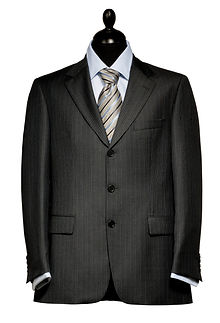WHITE TIE



SHANCES
Suit Guide
BUSINESS READINESS & SOCIAL ETIQUETTE




WHITE TIE
When invited to a white tie event, you must wear white tie attire, which includes a tuxedo with tails. There are elements that your tuxedo must have to be considered appropriate.
Tailcoat - Black with silk-satin
lapels tapered sharply at the front
rear vent
Trousers - Same fabric as the coat;
straight with silk-satin side stripes
Shirt - White winged collar double (aka French) cuffs
Waistcoat - White, heavy silk or cotton pique. V- or U-shaped, single or double breasted.
Tie - White pique bow
Jewelry - Onyx or pearl cufflinks and studs, NO gold (excluding wedding bands), NO wristwatch.
Pocket Square - White silk pocket square or handkerchief; long silk scarf.
Gloves - White leather or cloth carried in the left hand.
Hat - If worn, it should be a top hat.


BLACK TIE OPTIONAL
Black tie optional means that you may choose to wear either a tuxedo or a suit.
Suit - Dark-colored suit and a tie should be worn.
Tuxedo - If you choose to wear a tux, it should not have tails.
UNIFORM
Uniforms worn by military, police and fire personnel may be used in lieu of a tuxedo for black tie affairs.
SUIT
The key to any suit is the correct fit.
Shoulders - The suit shoulder should end at the body’s shoulders.
Buttons - The top button of a two-button suit or middle button of a three-button suit should always be buttoned. The last button of a three-button suit should be lower than your belly button.
Jacket Fit - A flat hand should slip easily into the suit under the lapels (when the top and middle buttons are fastened). If your fist fits in the same area without pulling the button the suit is too big.
Jacket Length - When placing your arms at your sides, the knuckles should be even with the bottom of your jacket.
Jacket sleeves - The end of the jacket sleeve should be five inches from the tip of your thumb and the sleeve should hang where your wrist and the base of your thumb meet.
Cuffs - Shirt cuffs should be visible, between a quarter and a half-inch.
Color - A basic suit wardrobe should include navy, grey, navy pinstripe and grey pinstripe colored suits.


BUSINESS CASUAL
This attire has become mainstream, especially during the summer months. The key is to dress casually while looking professional.
Polo Shirt - A casual, short-sleeved cotton shirt with a collar and several buttons at the neck.
Long Shirt - A shirt with a collar, sleeves, and buttons down the front.
Blazer or Tweed Sports Coat - A man's blazer is not a suit jacket. A suit jacket comes with a matching pant.
V-Neck Sweater with Long-Sleeve Shirt - A non-button sweater with a V-shape neck worn with a cotton long-sleeve shirt underneath.
Khaki Pants - Are made from heavyweight twilled cotton cloth and can be worn for business.
Chino Pants - Usually made from lighterweight twilled cotton cloth. They are dressier than khakis.
Dark Pants -A staple in business casual attire as long as they are not jeans.
BLACK TIE
When invited to a Black Tie event you must wear a tuxedo unless the invitation uses the word "optional", then and only then, can a suit be substituted for a tux.
Tailcoat -Traditional black wool; with no vent. Tux cuts and styles change
Trousers - Same material as jacket; side braid matches lapel face
Shirt - Traditional-white, turndown collar with French cuffs
Waistcoat - The cummerbund should be silk and match the jacket facings.
Tie - Traditional-bow tie; Modern-four-hand (school boy) tie
Jewelry - Onyx, pearl, gold, etc., cufflinks or studs, and wristwatch.
Accessories - White silk pocket square or handkerchief
Socks - Black silk.
Shoes - Black shoes patent or polished leather oxfords with a high polish.

BREAK
A break refers to how the bottom leg of a pant is positioned and falls. Breaks are a matter of personal style and the shoes being worn.
Medium Break - Pants will cover the top of the shoe and parts of the laces. Hems will slope toward the sole in the back.
Full Break - Deep crease along the front; covers about 2/3 to 3/4 of the laces on your shoe. Hem ending about a ¼” from the ground in the back. Socks generally do not show, even while walking.
Short break - Looks like “high waters” (hem above the ankle). Best suited for a slim, flat front trouser.
No Break - Cuff barely rests on the shoe. Also, there is no fold in the pants fabric.
.
